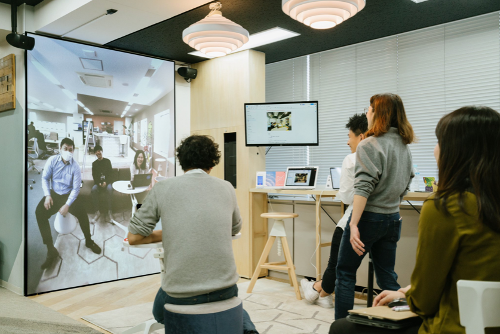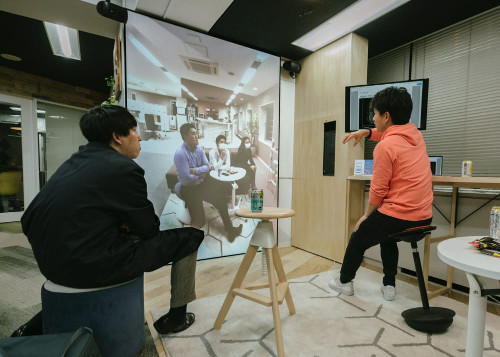
Perhaps you’re using them for team meetings, or maybe you’re using them to host a quarantini party for you and your friends.

Perhaps you’re using them for team meetings, or maybe you’re using them to host a quarantini party for you and your friends. Whatever the reason, video calls have become a whole lot more popular. Suddenly millions of people across the globe are using video calls, and for many of these it will be their first time properly using this medium. As a result, we’ve already seen quite a few epic fails and mishaps. Do you want to avoid becoming a video conference fail meme? Of course, you may want that, we all have different ambitions right now. If you want to perfect your video calls, below are some ways to help…
If you’re anything like us here at Kenyons, we all have an internet connection at home. But, if you’re anything like us here at Kenyons, that internet connection is stronger or weaker depending on where you’re sat.
Now, we’re not suggesting you should sit underneath your stairs if that’s where your internet connection is strongest – but it’ll help your video call experience if you can strike a happy balance between having somewhere comfortable to work and a stable internet connection. It’ll make for a smoother experience for both you and your colleagues/friends/family behind that screen.
If, however, you absolutely must sit somewhere with dodgy WiFi connectivity, we’d suggest reaching for the trusty LAN cable and connecting your laptop directly to your modem. It’s not exactly a sleek solution, but if it means you can sit in comfort all day, we say go for it!
Talking of which… If you’re going to be taking part in a video call you’ll want to make sure you’re sitting comfortably. Like a normal in-person meeting, you don’t want to be getting up and walking around whilst other people are trying to make a point. If you’re using a laptop you’ll want to make sure you’ve got it plugged-in or fully charged too. You don’t want to disappear mid-meeting because you’ve run out of pow…. (see what we did there?).
Naturally, your home isn’t going to resemble an office. Just look around yourself now and you’ll see the accoutrements and collections of your life. Paintings, furniture, ornaments, lights etc. The fact that we see these things everyday, can make them invisible to us. They won’t appear invisible to your co-workers though. This new era of video conferencing is giving us all an insight into the interiors of each other’s homes.
That’s a slightly wordy way of saying check your background!
And remember that your background isn’t static. If you’ve left a stack of dirty dishes on that table in the corner, or you’ve left your freshly laundered underwear piled up on that cabinet… your colleagues will get more of an insight into your life than you would probably want them to. So, get into the habit of checking your background and surroundings before diving into the next inevitable video call.
Oh, and whilst it can be tempting, you should try and resist the urge to place a carefully curated range of books or tasteful art prints behind you. They may be a good way of demonstrating the depth and breadth of your reading and art appreciation, but they are more likely to be a distraction and cause the viewers attention to drift… away from you.
It can be hard to find a quiet place at the best of times, but for video calls it’s particularly important. If you can find a spot where you won’t be disturbed by other family members/housemates/pets then that should probably become your go-to video call spot. It’s also a good idea to test how powerful your laptop/headphone mic is. They’re often more powerful than you think they are (meaning fellow video call participants may end up hearing things you don’t want them to). Most video conferencing apps have a tool in their settings for testing your mic. Give it a try now and you might avoid some embarrassing audio-based slip-ups on your next video call (you can thank us later).
As an aside, you’ll want to learn the art of the ‘tactical mute’ too. If you’re not talking then you should try and get into the habit of muting your mic. It’ll make the video call an easier experience for everyone. Depending on which video app you’re using, there are various keyboard shortcuts which help you to mute/unmute yourself rapidly (e.g. on Zoom you can do this using your spacebar).
This isn’t a normal in-person meeting where you can rock up dead on time. Unfortunately, video calls involve computers. Which means things can go wrong. When you least expect it. When you’re about to make a high-pressure pitch to that new prospect. So, yeah… you’ll want to get everything set up in advance. Apps such as Zoom and WebEx have features that allow you to see a preview of your picture and settings before a call starts.
As any sociologist worth their salt will tell you, we humans communicate using visual cues and facial expressions as well as our voices to talk to others. So when thinking about your video call set-up, make sure you’re taking lighting into account. If you want to get your lighting right without resorting to apps or other such technical gimmickry, do the following:
No one wants to see up your nose. It may be a lovely nose, but looking directly UP it is not exactly tres chic. So, get the angle of your camera right. Please. You should be aiming for your camera to be looking at you head-on and at eye-level. You don’t have to resort to any particularly complex elevating device here; a pile of books will usually suffice. Just like in real life you don’t want to convey that you are either looking up or down at someone. Keep things level and you’ll have a balanced video call.
Seeing as it’s likely to be a while before we’re all dressing ‘business casual’ again, it’s time to think about what you should wear when you want to be ‘video casual’. In truth, there’s not much difference between the two. You wouldn’t go to the office wearing your pyjamas, so you should avoid doing the same for video calls. Likewise, it’s probably not necessary to don a full suit if you’re participating in a video call. In fact, it may seem rather strange. When was the last time you spent a full day in your house in business attire?
Whilst this last point isn’t a tip, it’s something we really wanted to share with you. Because if it works it’s likely to be something we’ll all end up using at some point. It’s called Tonari (no, they aren’t sponsoring this article. We just really like the idea behind it).
As you can see from the pictures below, it’s like having a portal into another space. It looks like a fantastic way to feel more connected with the people on the other end of your video call. And, because it shows your entire body rather than just your face, it makes communication much more natural and intuitive – kinda like real life.

(Image via Tonari).
Here’s how the team at Tonari describe it:
“Being able to see a full life-sized body makes a really big difference for reading nuance and body language! A designer in the Osaka office mentions how cultural differences can make it difficult to read a coworker from Tokyo over applications like Zoom that only show the face.”
“Keeping Tonari *always on* really helped people share more information across offices. Because there’s no disconnect button, conversations flowed more casually from one topic to the next. We heard a lot of ‘Oh yes, I wanted to ask…’ and ‘By the way…’ during our field studies.”

(Image via Tonari).
“More casual and serendipitous conversations meant that people got stuff done more quickly. A stalled email discussion would quickly get resolved in a conversation over Tonari. People could quickly pull in other people needed to finalise a decision, without scheduling meetings.”
It certainly sounds interesting doesn’t it?
As always, we hope you’ve found our latest article of use (and we’d love you to share it with others).